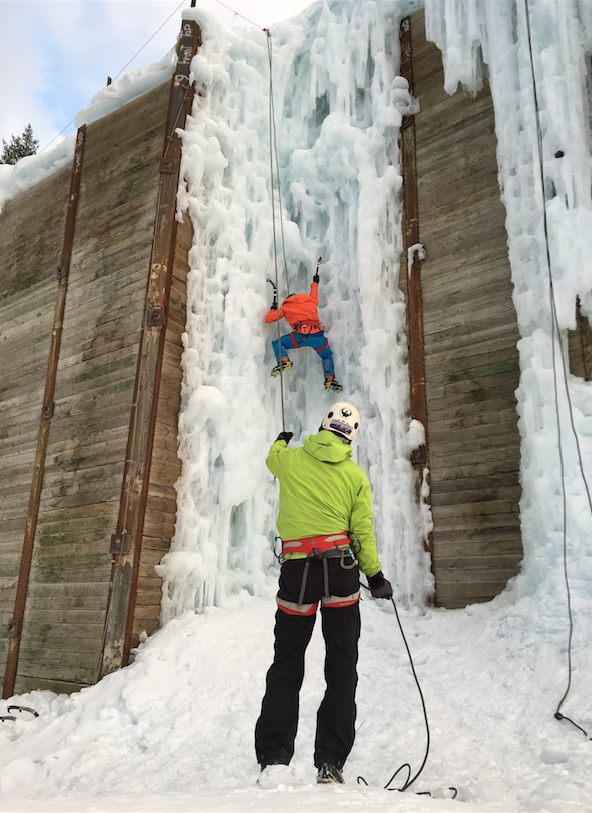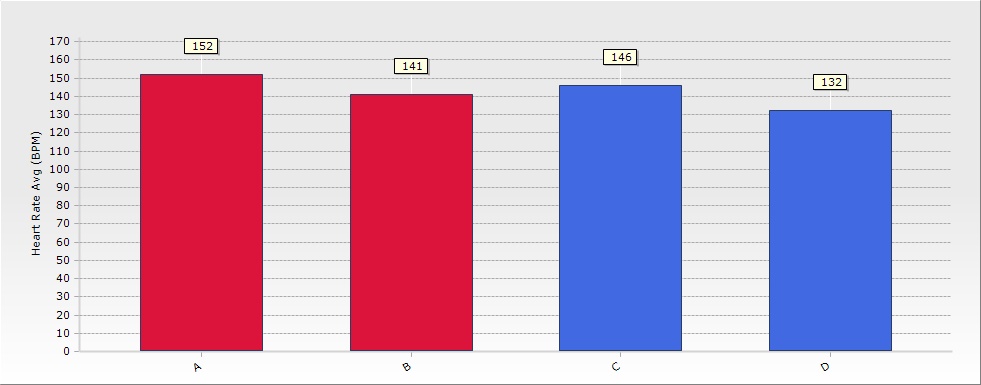
The sport of ice climbing is growing. Since the International Climbing and Mountaineering Federation (UIAA) organized the first Ice Climbing World Cup in 2002 the sport has seen double-digit expansion each year.
Even with this growth, research around the sport is lacking. So, once again, MTI decided to strap our Zephyr Bioharness on a few athletes to see if we could start chipping away at the mystery.
With this first case study, we wanted to test one of the most interesting physiological findings in rock climbing research. Rock climbing studies, like those of Grant et al. (2007) and Sheel (2003), have reported that the high HRs found during rock climbing do not correspond to higher demands in VO2 (1,4). Confronted with these puzzling findings, researchers have started to attribute the high HR and relatively low VO2 demands to a “fear or anticipation of falling…” (4). We were curious if we could find any support for this assumption in our ice climbers.
Here is what we did…
SUBJECTS
Our two athletes were experienced climbers and trainers – both had over 5 years of ice climbing experience and were regulars at the MTI gym. Below is a basic breakdown of the athletes’ demographics.

TRIALS
All ice climbing trials took place on the EXUM Ice Park in Jackson, WY. The case study consisted of 2 trials. Trial 1 was an initial climb of approximately 120ft (4 back-to-back 30ft climbs). After a 15 minute rest, athletes completed a second trial. Trail 2 was a 60ft (2 back-to-back 30ft climbs) on the same pitch. For uniformity, all data comparisons utilized only the initial 5 minutes of each trial.
RESULTS & DISCUSSION
The bioharnesses allowed us to assess a few basic physiological measures. To see if we could determine the effect of fear and stress on our athletes we first looked at their overall average heart rate (HRavg). This quick analysis revealed average HRs of 148 BPM and 145 BPM for Athlete 1 and 2, respectively – numbers which equate to approximately 74% HRmax and 83% HRmax. These findings are actually fairly close to the HRs which have been reported in competitive rock climbing studies( 77-85% HRmax) (3). GRAPH 1 shows our athlete’s HR during the initial 5-minute snapshot of each trial.
GRAPH 1: 5 Minute Snapshot of HR Over Time During Ice Climbing Trials
Green = Athlete 1, Trial 1
Blue = Athlete 1, Trial 2
Red = Athlete 2, Trial 1
Brown = Athlete 2, Trial 2

Next, since we didn’t collect VO2 data during the climbs we turned directly to our athlete’s stress and activity level. To do this we first looked at our athlete’s Heart Rate Variability (HRV) and then their accelerometer data (total activity level).
HRV is a measurement of the deviation between individual heart beats (R-R cardiac signals). This number is usually reported in milliseconds (ms) and measured as the root mean square of differences of successive R-R intervals (5-9). By looking at our athlete’s HRV we can actually see a psychophysiological measure of their stress.
Typically, decreases in HRV indicate increases in stress (10-12). As you can see in GRAPH 2 both athletes had significantly lower HRV during their first climb. We attribute this to the stress they felt during their initial pitch. Then, during the second trial, as the athletes became more comfortable on the ice, they were able to relax and thus, HRV increased significantly.
GRAPH 2: HRV During Climbing Trials
Red = Athlete 1
Blue = Athlete 2

Although the difference wasn’t near as large, the increase in HRV during the second trials corresponds with drops in HR. As you can see in GRAPH 3, our athlete’s both had lower HRs during their second climb – which, if a product of the decreased stress, would support the rock climbing assumptions mentioned above.
GRAPH 3: HRaverage During Climbing Trials
Red = Athlete 1
Blue = Athlete 2

Although it does appear that stress (measured by HRV) could be playing a major role in our athlete’s physiological demands before we can draw any preliminary conclusion we first need to see if any changes in physical activity might also be producing the change in HRs.
To do this we looked at our athlete’s physical activity and acceleration as captured by the bioharness’s accelerometers. Unfortunately, the use of accelerometry for physical activity measurement is not standardized and there is no direct translation into energy expenditure. However, assessing our athlete’s total activity does give us a quick snapshot of how much activity was required during their climb. Below in GRAPH 4, you can see each climb’s average activity (activity count, or vector magnitude units [VMU]) and average acceleration.
GRAPH 4: Average Activity (VMU) and Acceleration (g-Forces)
Red = Athlete 1
Blue = Athlete 2

As you can see, the physical activity and average acceleration were almost identical during each athlete’s two trials (A vs B and C vs D). Based on this, we can definitely say that the activity level alone does not account for the assessed change in HR. Furthermore, to put these numbers in perspective, based on previous assessments with our athletes, the activity and acceleration we measured are roughly equal to a brisk walk of 4-4.3 mph. This finding also gives additional support to the role of stress.
CONCLUSION
Physical activity alone can not explain the physiological demands of ice climbing. Our case study found that as much as 37% of an athlete’s ice climbing HR is related to their stress. This seems to support similar findings in rock climbing studies (1-4).
In the end, although the sport of ice climbing clearly requires demanding levels of finger strength, shoulder girdle strength, endurance, and hip flexibility, those attributes alone cannot account for HRs as high as 90-95% HRmax, and therefore do not fully capture the physiological demands of the sport (1). To do this, stress must be factored into the equation.
REFERENCES
- Grant, S; Hynes, V; Whittaker, A and Aitchison, T. Anthropometric, strength, endurance and flexibility characteristics of elite and recreational climbers. J Sport Sci: 301-309, 2007.
- Merrier, C; Janot, J; Parker, D and Swan, J. Physiological and anthropometric determinants of sport climbing performance. Br J Sports Med; 34: 359-366, 20000.
- Billat, V; Palleja, P; Charlaix, T; Rizzardo, P and Janel N. Energy specificity of rock climbing and aerobic capacity in competitive sport rock climbers. J Sports Med Phys Fit; 35: 20-24, 1995.
- Sheel, A. Physiology of sport rock climbing. Br J Sports Med; 38: 355-359, 2004.
- The Task Force of The European Society of Cardiology and The North American Society of Pacing and Electrophysiology. Heart Rate Variability. Euro. Heart J. 17: 354-381, 1996.
- Arffa, S. The Relationship of intelligence to executive function and non-executive function measures in a sample of average above average, and gifted youth. Archives of Clin. Neuropsychology. 22: 969-978, 2007.
- Thompson, A., Swain, D., Branch, J., Spina, R. and Grieco, C. Autonomic response to tactical pistol performance measured by heart rate variability. J. Str. Cond. Res. 29(4): 926-933, 2015.
- Saus, E., Johnsen, B., Eid, J., Riisem, P., Andersen, R. and Thayer, J. The effect of brief situational awareness training in a police shooting simulator: An experimental study. Mil. Psyc. 18(Supp): 3-21, 2006.
- Pocock, Gillian (2006). Human Physiology (3rd ed.). Oxford University Press. pp. 63–64. ISBN 978-0-19-856878-0.
- Belvisi, Maria G.; David Stretton, C.; Yacoub, Magdi; Barnes, Peter J. (1992). “Nitric oxide is the endogenous neurotransmitter of bronchodilator nerves in humans”. European Journal of Pharmacology 210 (2): 221–2. doi:10.1016/0014-2999(92)90676-U. PMID 1350993.
- Costanzo, Linda S. (2007). Physiology. Hagerstwon, MD: Lippincott Williams & Wilkins. p. 37. ISBN 0-7817-7311-3.
- Essential Clinical Anatomy. K.L. Moore & A.M. Agur. Lippincott, 2 ed. 2002. Page 199.
You Might Also Like MTI’s Expedition Mixed/Ice Climbing Training Plan